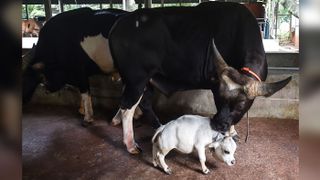This 20-inch-tall cow may be the smallest on Earth
Rani is a mini moo with big dreams.

Thousands of visitors are herding themselves to a small farm in Bangladesh to see what may be the world's shortest cow, according to news reports.
Rani, a fully grown 23-month-old Bhutanese cow, has been drawing crowds lately despite local COVID-19 restrictions. "I have never seen anything like this in my life," visitor Rina Begum told BBC News.
The half-size heifer, which has recently become a social media sensation, is in the process of being verified by Guinness World Records as the world's shortest cow, according to BBC News.
Rani stands a mere 20 inches (51 centimeters) tall, meaning that, once her measurements are verified, she will easily break the record set by Manikyam, a 24-inch-tall (61 cm) Vechur cow in India who is the current Guinness World Record holder. She's also quite the lightweight, at just 57 pounds (26 kilograms).
Related: 10 weirdest medical cases in the animal kingdom
So why is Rani so small?
One factor in Rani's stature is her breed. Bhutanese cows, like Vechur cows, are typically referred to as dwarf cows, as individuals of these breeds are bred to be small. Dwarf cow breeds are often produced for their ability to produce large amounts of milk without requiring much food. For dwarf cow breeds, climate can play a role in the animals' development. According to research conducted by Kerala Veterinary and Animal Sciences University and presented at the Steps to Sustainable Livestock International Conference in 2016, Vechur cows possess so-called thermometer genes that seem to stunt their growth in hot climates. These genes are favorable among breeds living in tropical climates, as smaller size likely helps the cows withstand extreme heat.
Sign up for the Live Science daily newsletter now
Get the world’s most fascinating discoveries delivered straight to your inbox.
But Rani is special for being a particularly tiny example of an especially diminutive breed, suggesting that more than her breed is at play.
Sajedul Islam, the Bangladeshi government's chief veterinarian for the region including Charigram, the town where Rani lives, told AFP as reported by France24 that Rani is a product of "genetic inbreeding" and was unlikely to become any bigger. According to Cobie Rutherford, a beef cattle associate with Mississippi State University writing in the 2015 issue of Cattle Business in Mississippi, cows are typically bred on farms through the use of a technique called line breeding, wherein one bull sires many generations of cows. While this form of inbreeding tends to preserve and accentuate desirable traits, it can also reveal some undesirable traits, such as dwarfism.
According to a 1969 study published in the New Zealand Journal of Veterinary Medicine, dwarfism is well-documented in cows and depending on the breed, dwarfism can lead toy either a shortening or elongation of the face as well as reduced life expectancy in affected animals. In the 1940s and 1950s, a form of dwarfism called snorter dwarfism became common among Hereford cows in the U.S. It turned out to be an autosomal recessive trait — that is, a gene that needs to be passed on from both parents in order to be expressed in offspring — that, if carried by the breeding bull, could be silently transmitted to his calves, according to a paper published in 1950 in the Journal of Heredity. This silent transmission becomes a problem when that same bull is bred with his own daughters, as is often the practice with line breeding, according to a factsheet on cattle inbreeding for Oklahoma State University.
There's no way to know for sure whether inbreeding wholly explains Rani's size. Ultimately, Rani's potentially record-setting size might very well be a result of both inbreeding and the genetics of her particular breed.
Rani's owner, Kazi Mohammad Abu Sufian, told the Washington Post that Rani is as timid as she is adorable. When not posing for pictures with her newfound fans, she prefers to spend much of her time alone, grazing away from other cows on the farm. Otherwise, Abu Sufian reports, Rani is a perfectly happy dwarf cow that likes to run "as fast as the rabbits we have on the farm."
Originally published on Live Science.

Cameron Duke is a contributing writer for Live Science who mainly covers life sciences. He also writes for New Scientist as well as MinuteEarth and Discovery's Curiosity Daily Podcast. He holds a master's degree in animal behavior from Western Carolina University and is an adjunct instructor at the University of Northern Colorado, teaching biology.
